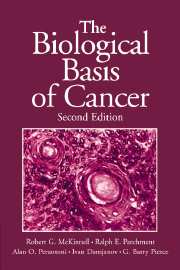Book contents
- Frontmatter
- Contents
- Preface
- Introduction: Letters illustrating clinical aspects of cancer
- 1 The pathology of cancer
- 2 Invasion and metastasis
- 3 Carcinogenesis
- 4 Genetics and heredity
- 5 Cancer-associated genes
- 6 Cancer in nonhuman organisms
- 7 Epidemiology
- 8 Lifestyle: Is there anything more important?
- 9 The stem cell basis of cancer treatment: concepts and clinical outcomes
- 10 Oncology: The difficult task of eradicating caricatures of normal tissue renewal in the human patient
- Appendix: Description of selected tumors
- Glossary
- References
- Index
- Plate section
Appendix: Description of selected tumors
Published online by Cambridge University Press: 05 June 2012
- Frontmatter
- Contents
- Preface
- Introduction: Letters illustrating clinical aspects of cancer
- 1 The pathology of cancer
- 2 Invasion and metastasis
- 3 Carcinogenesis
- 4 Genetics and heredity
- 5 Cancer-associated genes
- 6 Cancer in nonhuman organisms
- 7 Epidemiology
- 8 Lifestyle: Is there anything more important?
- 9 The stem cell basis of cancer treatment: concepts and clinical outcomes
- 10 Oncology: The difficult task of eradicating caricatures of normal tissue renewal in the human patient
- Appendix: Description of selected tumors
- Glossary
- References
- Index
- Plate section
Summary
Adenocarcinoma of the breast
Adenocarcinoma of the breast usually presents as a small painless mass (Figures A–a,b). The disease rarely occurs in the second and third decades but then increases in incidence through and past the menopause. Because of the seriousness and great range in age incidence of the disease, any mass in the breast must be viewed as cancer until proven otherwise (see letter in Introduction).
The stem cell population of the breast that will give rise to the milk-producing acini are located in the small ductules and persist in the fibrotic stroma of the senile breast. These stem cells are the target in carcinogenesis (Figures A–2 a,b,c). The majority of adenocarcinomas of the breast arise in these same small ductules. They may present in several ways: the vast majority develop as small solitary painless nodules, but some within the ductules may present with a bloody discharge from the nipple as the nodule develops. As the adenocarcinomas grow, they infiltrate surrounding tissues and eventually become fixed to the deep tissues and to the skin. This may cause dimpling of the skin or, if it invades the nipple, retraction of the nipple (Figure A–1a). With further growth and development it may spread first to the lymph nodes in the axilla, and shortly thereafter to the lungs, pleura, and to the bones of the spine and pelvis.
- Type
- Chapter
- Information
- The Biological Basis of Cancer , pp. 355 - 380Publisher: Cambridge University PressPrint publication year: 2006

